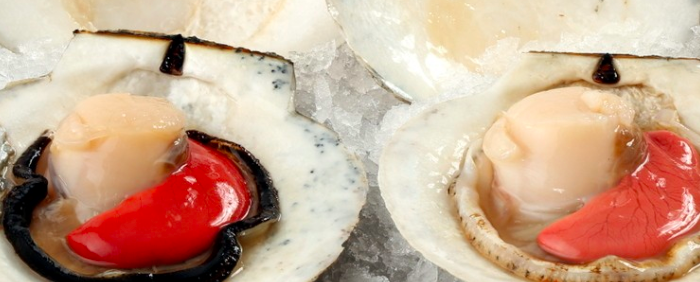
Description and history
The scallop is a mollusc of the pectinidae family which includes more than 300 species. It is made up of two ribbed valves, one of which is curved and the other flat. A headset is present on each side of the hinge which is held by a ligament. The color of the shell varies according to its habitat. It can be pink, reddish, brownish or yellowish and measures 9 to 15 cm. Its weight is on average 115 grams.
We find the scallop in Europe, in the Mediterranean Sea and the Atlantic. It is concentrated on the French and Spanish coasts.
Its name comes from the time when pilgrims who went to Santiago de Compostela, a place of pilgrimage in the Middle Ages in Spain, used empty shells to beg or to eat.
Nutritional value of scallops
| Per 100 g, raw | |
| Calories | 69 kcal |
| Carbohydrates | 3.2g |
| Protein | 12.1 g |
| Fat | 0.5 g |
| Vitamin B12 | 1.4 µg |
| Sodium | 392 mg |
| Phosphorus | 334 mg |
| Selenium | 13 mg |
Health effects of scallop
Vitamin B12
The scallop provides 50% of vitamin B12 needs . Cobalamin is essential for growth, cell division, the proper functioning of all cells in the body and the balance of the nervous system. It is involved more precisely in the synthesis of DNA and RNA, proteins, myelin (substance which forms a sheath around certain nerve fibers), in the formation of red blood cells, as well as in the metabolism of carbohydrates. and lipids.
The scallop is also a source of selenium . This mineral works with one of the main antioxidant enzymes, thus preventing the formation of free radicals in the body. It also helps to convert thyroid hormones to their active form.
Finally, the scallop is a source of phosphorus . Phosphorus is the second most abundant mineral in the body after calcium. It plays an essential role in the formation and maintenance of healthy bones and teeth. In addition, it participates among other things in the growth and regeneration of tissues and helps to maintain normal blood pH. It is one of the constituents of cell membranes.
Like most seafood, the sodium content is high (17% of the daily value). Excessive sodium intake can cause side effects including high blood pressure and loss of bone mass (osteoporosis). High blood pressure is an important risk factor for stroke, heart disease and kidney disease. It is therefore advisable to choose the basic and least transformed versions possible.
Uses
The scallop is eaten raw or cooked . Raw, it comes in tartare, carpaccio, sashimi, ceviche. Most often cooked, it is pan-fried, roasted or poached.
They are kept fresh or cooked in the refrigerator for 1 to 2 days maximum. The frozen version will keep for 3 months.
A word from the nutritionist
The scallop benefits from being more integrated into our diet. They contain vitamin B12 and selenium, important and rather rare minerals to find in such good quantities in food.